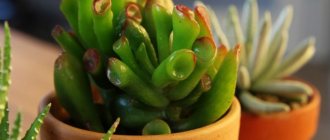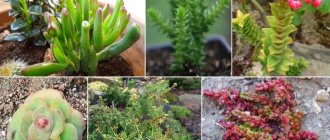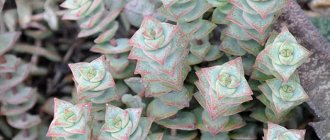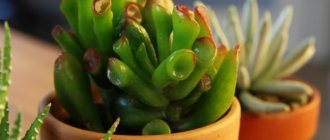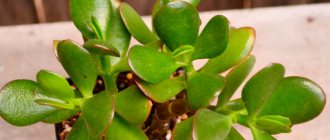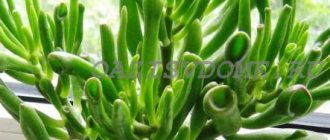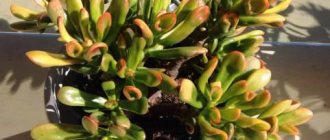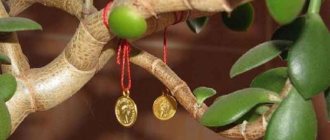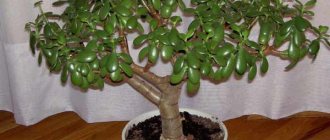International name:
Synonyms:
Characteristics:
| Complexity: |
| Development cycle: |
| Light mode: |
| Watering mode: |
| Temperature: |
| The soil: |
| Key Feature: |
Foliage color
Bud color
Dimensions Flower sizes
Taxonomy:
| Domain: |
| Kingdom: |
| Department: |
| Class: |
| Order: |
| Family: |
| Genus: |
Crassula Lycopodioides or Crassula Muscosa is a succulent plant belonging to the Crassula family. This small plant reaches 30-45 centimeters in height and is very branched.
The stems are succulent and very thin, mostly only the leaves are visible; they are straight but tend to bend over time. The leaves grow in rosettes of four and are arranged in a vertical position. Read more about this plant, as well as the features of caring for it, below.
Types and varieties of Crassula
The silver crassula has gained fame as the money tree, although sometimes the tree-like crassula is also called that. However, the world of Crassula is so large that collectors of succulent plants create entire indoor gardens from these plants. Many rare species can be found in flower shops in pots called mix (1).
Crassula oval, or ovoid (Crassula ovata). A fairly large, fast-growing plant up to 150 m in height with oval glossy leaves of green or gray-silver color. Small white or pink flowers are collected in apical umbels. Unlike other species, it is shade-tolerant.
This species has several interesting varieties.
- Blue berd is a small tree with curly bluish-blue leaves that sit tightly on the trunk; this variety is often sold as Crassula arborescens;
- Crosby's Compact - has a compact shape, small pale red leaves, used in indoor mini-gardens.
- Sunset is a spectacular variety with tricolor leaves: stripes of yellow and white and a red border on a green background.
- Hobbit is a very original variety with everted or fused leaves, bred by American breeders in the late 70s of the last century.
Variety Crosbys compact. Photo: pixabay.com
Variety Crosbys compact. Photo: pixabay.com
Hobbit variety. Photo: pixabay.com
arborescens . Outwardly, it is similar to Crassula ovoid: a powerful trunk and bare branches, fleshy, flat, rounded grayish leaves with a pale blue tint and a red border. The flowers are white or pink, but it blooms extremely rarely indoors. Loves bright sun (1).
Presented not by varieties, but by forms:
- undulatifolia - with flat narrow leaves of silver-blue color and characteristic red tips;
- undulatifolia variegata - with a white stripe along the edge of the leaf;
- curly (curviflora) - has a pronounced wavy edge on the leaves.
Crassula arborescens undulatifolia.
Photo: pexels.com Silver Crassula, or purslane (Crassula portulacea). This is one of the types of money tree. Very similar to Crassula tree-like and oval. But this plant is more compact, in cultivation it reaches 1 m. The trunk is almost even, narrowing only at the top. The leaves are oval, placed in pairs opposite, but each pair is located perpendicular to the previous one. It blooms rarely, with light pink, odorless flowers in racemes.
Crassula Buddha's Temple. The dream of many gardeners. This is an unusual type of Crassula - the result of crossing Crassula pervoliata and pyramidal. It was created in 1959 by the American breeder Myron Kimnah, an amazing gardener who had no special education (2).
Crassula Buddha's Temple. Photo: YouTube
The plant has the appearance of a column; tightly pressed triangular leaves of dark green color are strung on the stem. The apical inflorescences consist of red flowers. As soon as the Crassula reaches a height of 15 cm, the stem falls on its side. Therefore, the plant is grown in compositions with stones that can support it.
It may be sold under the names Kimnachi or Myron Kimnach.
Facts about Mossy Crassula (Crassula Lycopodioides or Muscosa)
The pointed leaves of Crassula moss are completely green and quite small (usually less than 0.5 centimeters in length). The rosettes of leaves are highly compacted, making the stem invisible. As a result, the bush looks like many lizard tails.
Green tailed lizards. Photo used as illustration. Source: Yandex.Images
It is in the scaly leaves that all the unusualness and beauty of this Succulent is concentrated. In addition, the plant can bloom. The flowering season begins in mid-autumn: at this time very small buds should appear (they may not be visible due to their size and yellow-green color).
This is interesting! Flowering is accompanied by a musky aroma. In small quantities this smell is pleasant, but if several of these plants bloom, it becomes too intrusive and sometimes unpleasant.
Caring for crassula flowers at home
The types of Crassula are so diverse that many gardeners do not stop at one plant, but collect a whole collection. It is not difficult to maintain because the plants are unpretentious. The main task is not to fill it with water!
But not everyone succeeds in achieving flowering. This requires time, care, summer at the dacha and cool keeping in winter - from 10 to 15°C.
Priming
Soil for Crassula can be bought ready-made, marked “for succulents”. Or prepare it yourself, remembering that it should be light, well-drained, permeable to air, neutral or slightly acidic (within 5.5 - 6.5 pH). The soil for Crassula consists of turf soil, leaf humus, mature compost and coarse sand or perlite (1: 3: 1: 1). The second option is used for ground cover and miniature species of Crassula - turf soil, leaf humus and coarse sand (2:2:1).
Lighting
Most types of Crassula prefer a high degree of illumination, but it is better to place them on windowsills facing east or southwest. In the summer, the pots can be moved to the loggia or garden. To avoid sunburn, plants should be protected during midday hours with a light net.
“To ensure that plants develop evenly, regularly turn the pot towards the light source,” advises plant collector Elizaveta Starostina.
Humidity
Crassulas are drought-resistant due to the fact that they accumulate moisture in the fleshy stems and leaves. In summer, plants are watered after the top layer of soil dries, in winter - until the soil dries to a depth of 2 - 3 cm. In practice, this means that in summer Crassulas are watered once every 2 weeks, and in winter once a month. Overwatering is detrimental to the plant - the roots begin to rot. But prolonged drought also leads to wrinkling and falling of leaves.
These plants do not need spraying or high humidity, but they respond very well to washing the leaves with clean water using a cotton pad.
Fertilizers
When planting Crassula in the soil, you need to add fertilizer for succulents, but use half the dose recommended by the manufacturer. They also need wood ash (no more than 1 teaspoon per pot).
Feeding
In the spring-summer period, Crassulas need feeding: once every 3-4 weeks, the plants are watered with a fertilizer solution for succulents or cacti. From September, feeding is stopped. However, if the plants are kept warm, it is recommended to feed them once every 40 days.
Flower growers often use water-soluble, slow-release fertilizer in the form of sticks.
Trimming
Some types of Crassula require formative pruning. The shape of the tree begins to be created in a young plant so that the trunk turns out smooth and beautiful. As soon as the young plant reaches a height of 15 cm, two leaves are plucked out at the top - two new shoots will begin to grow in their place. Next, you will need to regularly remove leaves in those places where you want to get branching.
Species with climbing or rosette leaves also need pruning. But this, as a rule, happens only after flowering, when the part of the rosette where the flowers were begins to die.
What it is?
Botanical characteristics, homeland and distribution
Crassula perforata, synonymous with Crassula perforata, belongs to the genus of succulents of the huge Crassula family.
According to different classifications, the genus includes 300–500 species.
Natural habitat:
- tropics of Africa;
- Madagascar;
- southern regions of Arabia.
The Crassula genus is a tropical evergreen plant that grows only in the Southern Hemisphere.
In everyday life, the flower is called the money tree, the tree of happiness.
Literally translated, Crassula means “thick,” which characterizes the fleshy, dense structure of the leaves.
Description of appearance
The variety of Crassula perforatum is classified as a columnar variety.
The trunk is straight, long, dense, does not branch, and grows through the leaves. The stems grow more than 20 cm in height, densely leafy.
The leaves can be diamond-shaped or round, dense, thick . The color of the leaves is green, with a bluish coating. From the bright sun, the leaves at the edges acquire a reddish tint. The leaves are up to 3 - 4 cm wide, grow oppositely, in tiers, fused with each other at the base.
Important! The flower can be grown as an ampelous plant.
The inflorescences are umbellate panicles; there are varieties with racemose inflorescences. The flowers are located at the top of the stems. The flowers themselves are miniature, numerous, white with a yellowish tint, and fragrant at the very beginning of flowering. Flowering most often occurs in winter and lasts up to 1.5 – 2 months.
Photo
Here you can see a photo of the Perforated Crassula:
Is it easy to grow and how long does it last?
Crassula perforatum is an unpretentious flower, grows quickly, bushes well, and gives good annual growth.
A flower grown at home is significantly smaller in size than natural specimens. But over time it grows into a dense, decorative bush. It rarely blooms in an apartment ; flowering requires additional stimulation - a certain temperature regime and limited watering.
Important! To maintain the shape of the bush, pinching the shoots is mandatory.
It propagates easily, takes root quickly, and can be combined with other indoor flowers. With proper care and renewal, the bush can live for more than 10 years.
Reproduction of Crassula at home
Crassulas reproduce by seeds and cuttings.
Seeds. Seeds are sown in wide bowls superficially on a substrate of sand and leaf soil (1:2). The bowl is covered with film or covered with glass, and placed in a bright and warm place. Condensation is removed and ventilated daily.
The first shoots appear after 15 - 20 days. Grown-up specimens are planted in separate small pots with a light substrate of turf and leaf soil and sand (1:2:1). Seedlings are grown at a temperature of 16 - 18 ° C in a bright place.
By cuttings. Propagating Crassula by cuttings is much easier and faster. Not only stem segments, but also leaves are suitable for rooting. The cut areas are dusted with crushed charcoal and dried for 2 - 3 days. Then they are planted in a light substrate of leaf soil and sand.
You can also root the cuttings in cups of water by adding half a tablet of activated carbon. After the roots appear, the cuttings are planted in small pots with a light substrate.
After 1 - 2 months, the rooted plants can be planted in permanent pots and cared for like adult plants.
Humidity
The plant tolerant of dry air, but suffers seriously humidity . Fungal infections immediately appear rot . to avoid additional spraying .
In winter, the fat plant is removed away from the battery. It is advisable to remove accumulated dirt and dust from the surface of the plates using a damp sponge.
Transplanting Crassula at home
The first transplant is done 14 - 30 days after purchase in order to replace the transport soil with nutritious soil. The pot is selected a little wider than the one in which you bought it.
Then transplants are done either urgently (if the plant is sick) or as the root system fills the pot. In some cases, a transplant is done once every 5 years. If the goal is to see Crassula bloom, then replanting must be done every two years.
It is important to choose the right pot. It should be wide, but not deep, since the root system of Crassula is superficial. For tall species, the pot should be heavy enough with a wide bottom to prevent it from tipping over under the weight of the crown.
A layer of drainage at least 2 cm thick must be laid at the bottom. Small pieces of red brick or a clay pot perform this role very well.
The soil must have good water and air permeability. Even in special soil for cacti and succulents, add 1 part of coarse sand or perlite. Transplantation is done using the transshipment method. If the root system has grown too wide, then it is slightly trimmed and the sections are dusted with crushed coal.
To obtain a compact crassula bush, replanting is done once every 5 years, into a pot that is no more than 3 cm wider in diameter. To improve nutrition, the top layer of soil is removed every year, replacing it with fertile soil.
Recommendations
| Wikimedia Commons has media related to Crassula pellucida . |
| Wikispecies has information related to Crassula pellucida |
- Doreen Court (2000). Lush flora of southern Africa
. CRC Press. paragraph 100. ISBN 978-90-5809-323-3.
| Taxon identifiers |
|
Crassula diseases
Bacterial burn. Its main manifestation is red spots on the leaves.
Diseased leaves need to be removed, plants should be sprayed 2-3 times with Fitosporin-M (3) with an interval of 10 days.
Yellowness of leaves. It causes the leaves to gradually change color to yellow.
Treatment consists of removing the affected shoots.
Mosaic epiphyllum. It destroys plant tissues - transparent, blurry yellow spots appear on them.
Treatment is impossible, the plant is destroyed.
Fusarium. First it affects the roots, then penetrates the stems and leaves. Crassula stops growing, the leaves turn pale and become lethargic, and a rusty tint is visible on the cut.
Diseased areas are cut out, sprayed with Fitosporin-M solution (3), dried, and replanted in fresh soil.
Anthracnose (brown spot). Appears in the form of round light or brown spots on leaf plates.
At the initial stage, diseased parts of the plant are cut out, and the sections are sprinkled with charcoal. Then spray 2 - 3 times with a solution of Fitosporin-M (3) with an interval of 10 days.
Light
The plant loves bright light, so it is placed on windows facing south . When the sun's rays are too strong, a red border forms along the edge of the leaf blades.
This is not scary for the plant; it adapts to new conditions. However, if the grower wants to get uniform green foliage, it is better to protect the flower from excess ultraviolet radiation.
Crassula has the property of stretching towards the light, so it needs to be regularly rotated so that all sides receive enough sun.
Crassula pests
Mealybug. This pest settles in the axils of leaves and roots. And it looks like a white cotton-like coating.
First you need to rinse the plant under running warm water. Then use alcohol. But do not spray it, but treat the trunk and leaves with a cotton swab, moistening it in the solution. If it is possible to take the plants out onto the balcony or into the garden, then the infected Crassula should be sprayed with Actellik or Fufanon solution (3).
Spider mite. It populates Crassula in warm and dry rooms. Pests pierce the leaves and feed on the sap of the plant, inhibiting it.
The first thing to do is to thoroughly rinse the plant in the shower, first whipping the soap into foam and applying it to the trunk and leaves. For a day, the washed plants are placed in a large plastic bag to maintain high humidity. Then the plant is treated with Antiklesch, Apollo or Fitoverm (3).
Shield. The pest looks like dense tubercles.
This is a fairly large insect, so it is first removed from the plant by hand and destroyed. Then wipe the affected areas with a cotton pad moistened with alcohol. Double spraying with Actellik or Fitoverm (3) is effective.
Trimming
Forming pinching is needed to create three-dimensional spherical shape. Cut off shoots that stand out from the total volume or are too elongated . The procedure is carried out regularly , then the recovery process will go much faster.
the lower and branched are removed from young shoots . At the beginning of autumn, pinching of the apical shoots is carried out. Then even more leaves will appear on the Crassula.
